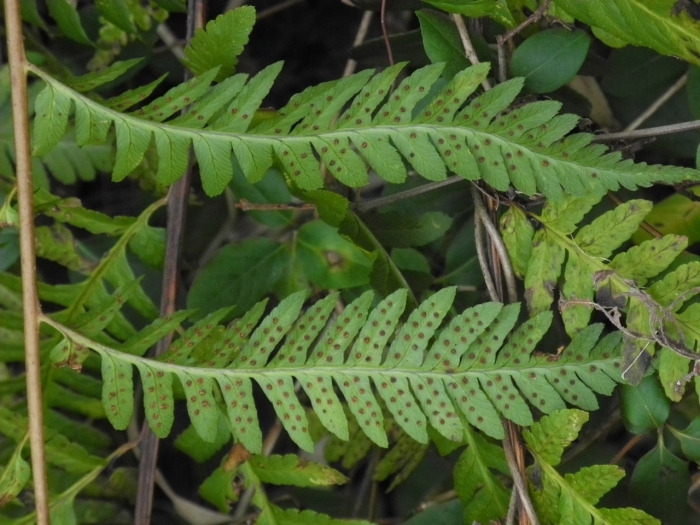Log Fern
(Dryopteris celsa)
Log Fern (Dryopteris celsa)
/
/

© Michael J. Papay
CC BY 4.0
Image By:
© Michael J. Papay
Recorded By:
Copyright:
CC BY 4.0
Copyright Notice:
Photo by: © Michael J. Papay | License Type: CC BY 4.0 | License URL: http://creativecommons.org/licenses/by/4.0/ | Uploader: mjpapay | Publisher: iNaturalist |



















Estimated Native Range
Summary
Dryopteris celsa, commonly known as Log Fern, is a semi-deciduous fern native to the southeastern United States, particularly thriving in the moist, shaded environments of bottomland forests, swamps, and along stream banks. It typically grows to a height of 3-4 feet (0.9-1.2 meters) and a width of 2-3 feet (0.6-0.9 meters). The Log Fern has a lush, upright growth habit with broad, arching fronds that are deep green in color. It is not known for flowers or showy fruit but is valued for its attractive foliage and the texture it adds to shady garden spots.
Log Fern is appreciated for its adaptability to the shady conditions often found under trees and its ability to provide a lush, green backdrop in woodland gardens. It is commonly used as an understory plant, in shaded borders, and in naturalized areas where it can form dense colonies. This fern prefers consistently moist, well-drained soils rich in organic matter. It is relatively low-maintenance, requiring little care once established, and is generally free from serious pest and disease problems. However, it can suffer from root rot if the soil is too wet. Gardeners should be aware that while it is not invasive, it can spread by rhizomes and may need to be managed in smaller spaces.CC BY-SA 4.0
Log Fern is appreciated for its adaptability to the shady conditions often found under trees and its ability to provide a lush, green backdrop in woodland gardens. It is commonly used as an understory plant, in shaded borders, and in naturalized areas where it can form dense colonies. This fern prefers consistently moist, well-drained soils rich in organic matter. It is relatively low-maintenance, requiring little care once established, and is generally free from serious pest and disease problems. However, it can suffer from root rot if the soil is too wet. Gardeners should be aware that while it is not invasive, it can spread by rhizomes and may need to be managed in smaller spaces.CC BY-SA 4.0
Plant Description
- Plant Type: Fern
- Height: 3-4 feet
- Width: 1.5-2.5 feet
- Growth Rate: Moderate
- Flower Color: N/A
- Flowering Season: Non-Flowering
- Leaf Retention: Semi-Deciduous
Growth Requirements
- Sun: Part Shade, Full Shade
- Water: Medium
- Drainage: Slow, Medium
Common Uses
Border Plant, Deer Resistant, Low Maintenance, Rabbit Resistant
Natural Habitat
Native to bottomland forests, swamps, and stream banks in the southeastern United States
Other Names
Common Names:
Scientific Names: , Dryopteris celsa, Dryopteris ×atropalustris, Dryopteris wherryi, Dryopteris goldiana subsp. celsa, Aspidium goldieanum f. celsum, Aspidium goldieanum var. celsum, Dryopteris clintoniana f. atropalustris, Dryopteris clintoniana f. celsa, Dryopteris clintoniana var. atropalustris
GBIF Accepted Name: Dryopteris celsa (W.Palmer) Knowlt.